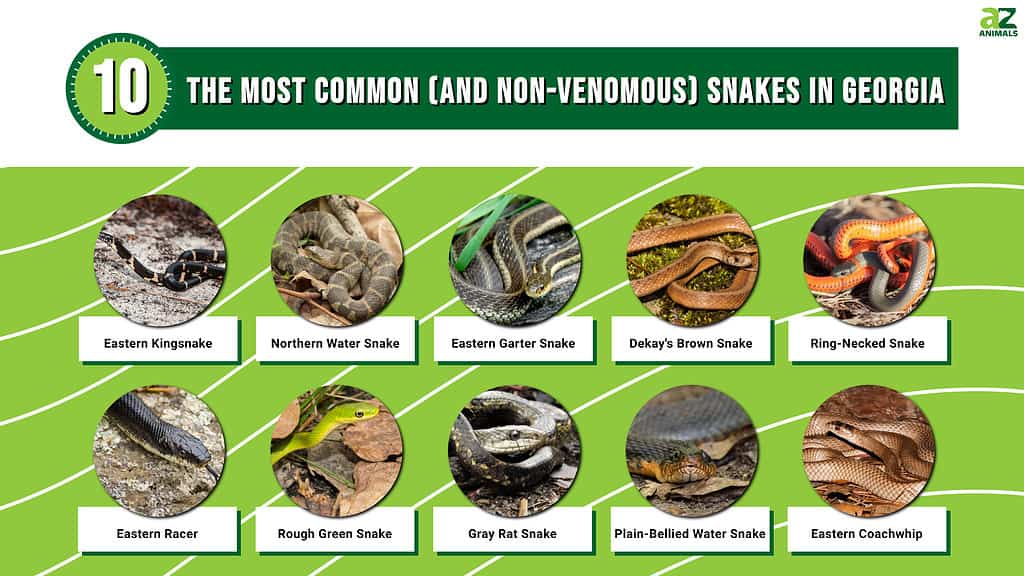
Spanning 57,000 square miles, Georgia has a diverse range of habitats that are home to thousands of wonderful animals. While some animals are incredibly rare or secretive and are hardly seen, there are others that we are much more likely to come across.
Some of these animals are snakes and with 46 species of snakes calling Georgia home, it’s not surprising that there are quite a few that fall into that category. So join us as we discover some of the most common (and non-venomous) snakes in Georgia!
Eastern Kingsnake

Eastern kingsnakes are known for being top predators of other snakes – including venomous ones
©iStock.com/JasonOndreicka
Also known as the common kingsnake, eastern kingsnakes are non-venomous snakes that are also popular as pets. They are typically between 36 and 48 inches long and are known for their shiny scales. In fact, the first part of their scientific name – Lampropelitis getula – means “shiny shields”. Eastern kingsnakes are usually dark brown with white crossbands and a chain-like pattern down their sides.
They prefer open habitats such as grasslands and prairies close to rivers and streams. Eastern kingsnakes are constrictors and eat rodents, birds, lizards, and frogs. They also eat other snakes – including venomous copperheads and coral snakes – and the “king” part of their name refers to them preying on other snakes.
Northern Water Snake
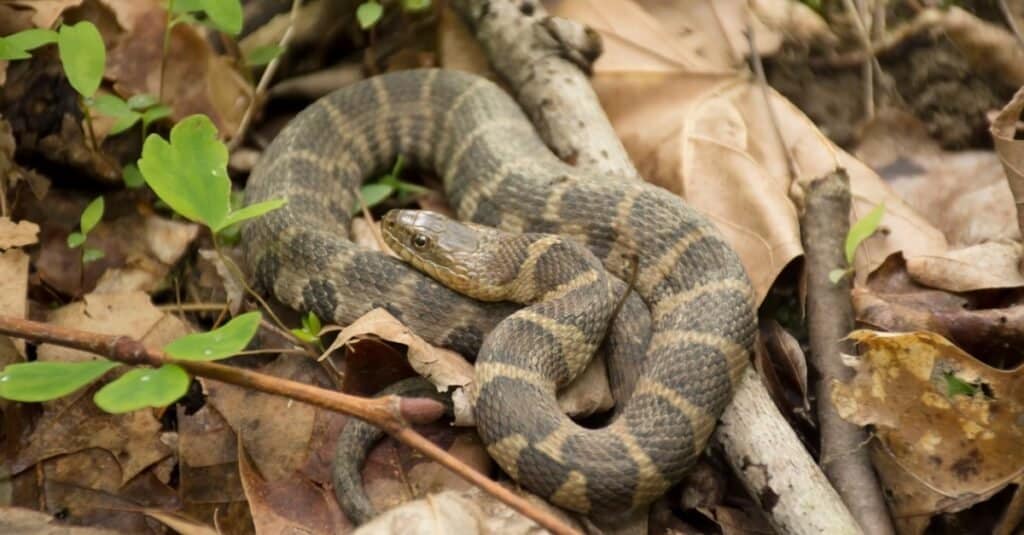
The northern water snake has a flat head that is as wide as its neck.
©iStock.com/IcemanJ
One of the largest common snakes in Georgia is the northern water snake which can reach almost 4.5 feet long. Northern water snakes are typically brown with darker crossbands on their neck and blotches down their back. They are always found near permanent water sources such as streams, ponds, rivers, lakes, and swamps.
During the day they can often be seen basking in the sun on rocks and logs. Northern water snakes hunt along the water’s edge and in the shallows and they typically eat fish, frogs, birds, and salamanders. Although they are not venomous, their saliva contains an anticoagulant (blood thinner) which means that any bite bleeds much more than usual.
Eastern Garter Snake

Eastern garter snakes are one of the most common snakes in North America
©Erik Agar/Shutterstock.com
Described as being one of the most widespread snakes across North America, eastern garter snakes are easy to spot with their unique striped pattern. They are 18 to 26 inches long and are brown or greenish brown with a distinctive yellowish stripe. Eastern garter snakes live in a wide variety of habitats, including entering urban parks.
They like to bask in the sun but quickly flee underneath logs and rocks at the first sign of danger. Although they are not venomous to humans, eastern garter snakes are mildly venomous to their prey. They lack fangs with which to inject it so instead it is produced in their saliva. Their prey includes frogs, toads, and worms, but they will eat anything else they can catch.
Dekay’s Brown Snake

Dekay’s brown snakes are small and often preyed upon by other snakes
©Jay Ondreicka/Shutterstock.com
Also known as the brown snake, Dekay’s brown snakes are small snakes that are usually less than 12 inches long. They have thin bodies and are usually brown with a lighter central stripe. Dekay’s brown snakes favor wetland habitats and – although secretive – are widespread across Georgia. They mainly prey on earthworms and slugs. Due to their small size, they are often preyed upon by larger snakes.
Ring-Necked Snake
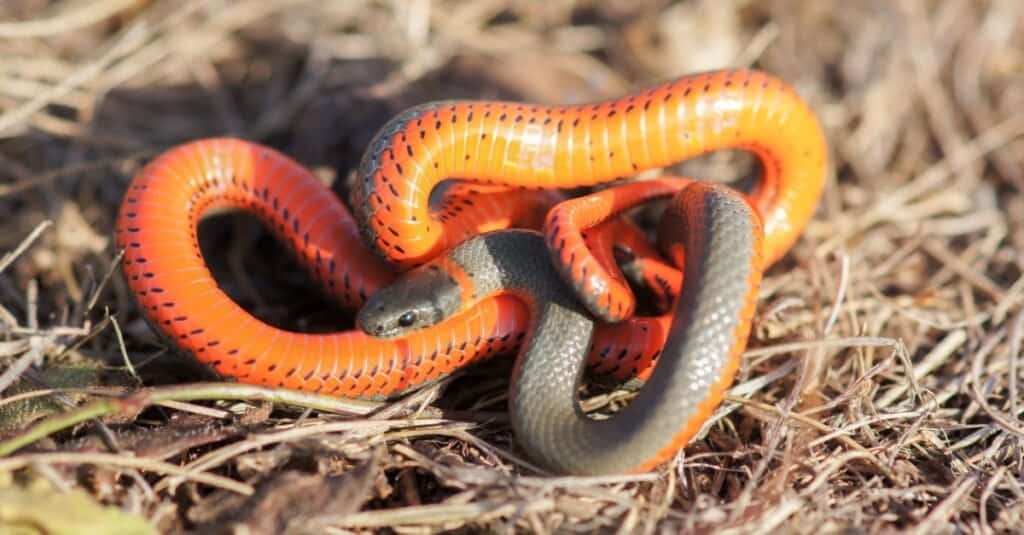
Small and colorful, the ring-necked snake is nocturnal and non-venomous.
©yhelfman/Shutterstock.com
Despite their secretive nature, ring-necked snakes are actually one of the most common snakes in Georgia – and one of the smallest at only 8 to 14 inches long. Although they are black on their dorsal side, ring-necked snakes are easily one of the most stunning due to the bright ring of color around their neck and bright bellies.
Their neck ring and bellies can be red, orange, yellow, or even red fading to yellow which makes them easily distinguishable from other snakes. As they are so secretive, ring-necked snakes prefer habitats where there is plenty of vegetation for them to hide under – such as woodlands or rocky hillsides. Ring-necked snakes produce a mild venom-like substance that they use to immobilize their prey – mainly salamanders – but they are not truly venomous or dangerous to humans.
Eastern Racer
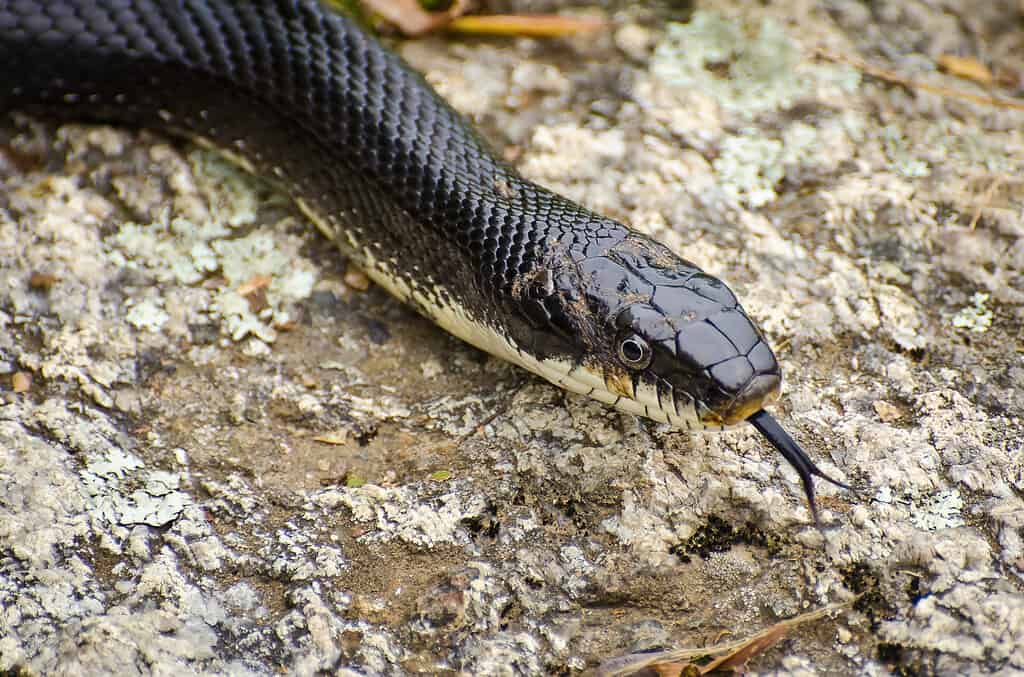
The southern black racer is the subspecies most likely to be seen in Georgia
©iStock.com/RCKeller
With eleven recognized subspecies, eastern racers are one of the most frequently seen snakes across North America. They vary greatly in size – being between 20 and 60 inches long – and in appearance. Their color is usually either black, tan, green, blue, or brown depending on the subspecies, while their bellies are typically a lighter color than their dorsal side.
Eastern racers are fast, active snakes that usually live in grassland habitats. However, they are also excellent climbers and often raid bird nests for eggs and chicks. Southern black racers are one of the more common subspecies and are the one that is most likely to be seen in Georgia.
Rough Green Snake

Rough green snakes often sleep coiled around tree branches
©iStock.com/BobMcLeanLLC
One of the most stunning green snakes in Georgia is the rough green snake which is a vibrant green on its dorsal side with bright yellow or cream belles. Rough green snakes are 14 to 33 inches long and typically live in meadows and woodlands. They are excellent swimmers and they are never far from a permanent water source.
Rough green snakes are also highly accomplished climbers and spend much of their time in trees. They are active during the day and often spend the night coiled around tree branches. Rough green snakes mainly eat small animals such as insects and spiders.
Gray Rat Snake

As well as being one of the most common snakes in Georgia, gray rat snakes are also one of the largest as they can reach more than 6 feet long.
©Gabbie Berry/Shutterstock.com
Also known as the chicken snake, gray rat snakes get their nickname as they sometimes kill and eat chickens. Aside from chickens, their diet includes rodents and other birds while juveniles prefer frogs and lizards. As well as being one of the most common snakes in Georgia, gray rat snakes are also one of the largest as they can reach more than 6 feet long.
They are typically a grayish color with dark brown blotches down their bodies. Gray rat snakes are adaptable and live in a range of habitats, although forests, tree-lined fields, and streams are preferred. They are excellent climbers and can be found at any height in trees – even up to the top.
Plain-Bellied Water Snake

Widespread across the southeastern region of the United States, plain-bellied water snakes always live near permanent water sources. Although they are always in and around freshwater habitats such as rivers, lakes, streams, and swamps, plain-bellied water snakes spend more time out of the water than other water snakes do.
Despite this, they rely heavily on the water for their prey which is mainly fish and amphibians. Plain-bellied water snakes are 24 to 40 inches long and are usually brown, gray, or black with a plain yellow or orange belly, although their color varies depending on the subspecies. Plain-bellied water snakes are most active during the summer months and hibernate during the winter.
Eastern Coachwhip
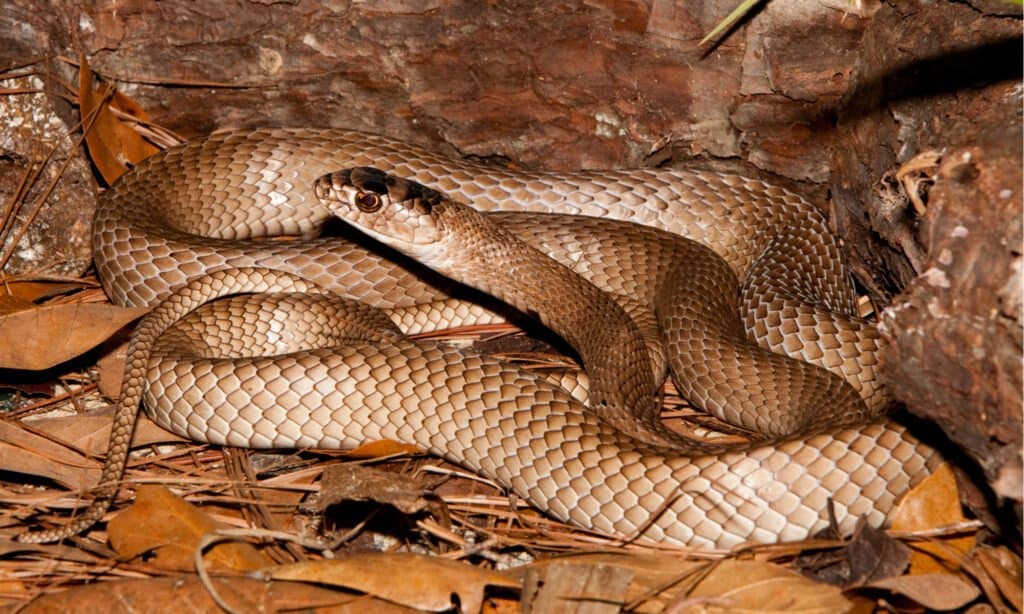
Eastern coachwhips have shiny scales that look like a braided whip
©Jay Ondreicka/Shutterstock.com
Another common snake in Georgia is the eastern coachwhip which is one of six subspecies of the coachwhip snake. Eastern coachwhips are 50 to 72 inches long and have slender bodies. Their heads are black but their bodies are brown which lightens towards the tail. They have smooth, shiny scales which tend to give the appearance of a whip, hence their name.
Eastern coachwhips live in many habitats, although swamps and pine woodlands are particularly favored. They are quick, active snakes that hunt during the day using their sense of smell and sight.
It’s not uncommon to see them scanning the nearby area with their head raised above the ground while looking for prey. They are not constrictors and eat birds, lizards, snakes, and rodents. Although most prey is swallowed alive, they sometimes beat them against the ground to stun them first.
How Many Venomous Snakes Are There in Georgia?
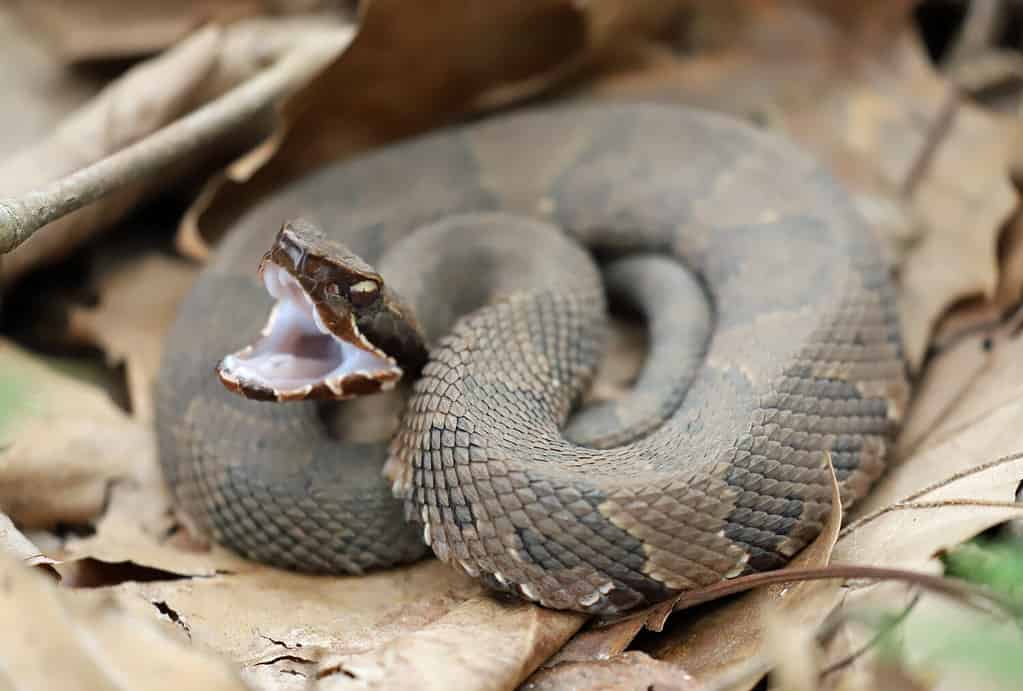
The cottonmouth is one of the six venomous snakes found in Georgia.
©KF2017/Shutterstock.com
While Georgians can rest assured that the state’s 39 non-venomous snake species are not threatening to humans, and even helping to control rodent populations, there are six venomous snake species in Georgia that residents should be aware of. The bite of a venomous snake can cause pain, inflammation, illness, and even death if not treated. The six venomous snakes in Georgia include:
- Copperhead
- Pigmy Rattlesnake
- Timber Rattlesnake
- Cottonmouth
- Eastern Diamondback Rattlesnake
- Eastern Coral Snake
Recorded snake bites in Georgia have been on a steady rise, with factors like the housing boom and increasingly warmer temperatures possibly playing a part. For example, in 2019 there were almost 400 reported snake bites, with almost 100 cases of antivenom being administered as treatment. The previous year, the snake bites were around 350.
Of the venomous snakes, the timber and eastern diamondback rattlesnakes are the most deadly, while the cottonmouth can also be deadly if the bite is left untreated.
Other Reptiles Found in Georgia
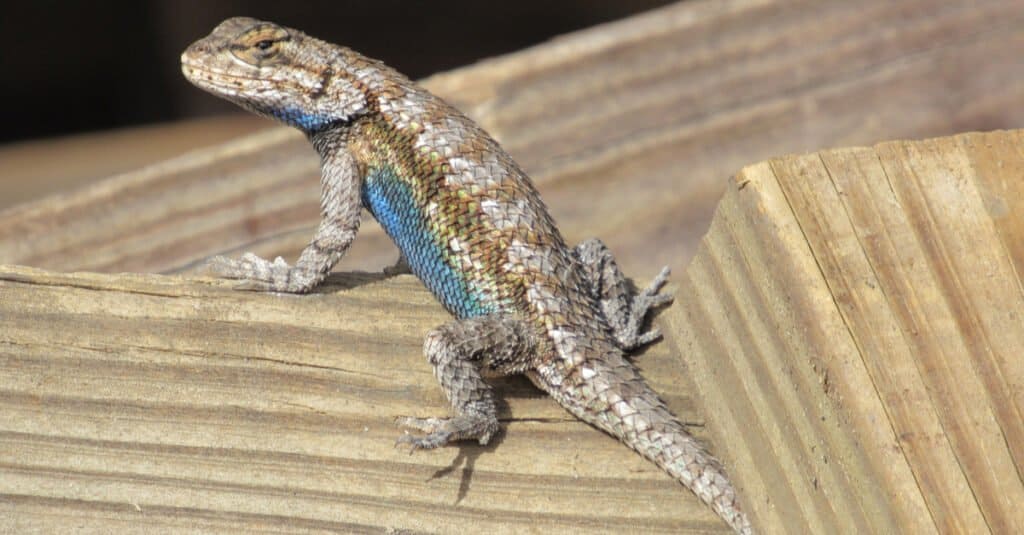
The Eastern fence lizard is commonly found in Georgia.
©Isabel Eve/Shutterstock.com
A wide variety of reptiles can be found in Georgia, from common species like the Eastern box turtle and common snapping turtle to more elusive and exotic animals like the American alligator and eastern diamondback rattlesnake.
Here is a short list of other reptiles found in Georiga:
- Green anole
- Six-lined racerunner
- Eastern fence lizard
- Common Five-lined skink
- Broadhead skink
- Slender glass lizard
- American alligator
Summary of 10 of the Most Common (and Non-Venomous) Snakes in Georgia
| Number | Snake |
|---|---|
| 1 | Eastern Kingsnake |
| 2 | Northern Water Snake |
| 3 | Eastern Garter Snake |
| 4 | Dekay’s Brown Snake |
| 5 | Ring-Necked Snake |
| 6 | Eastern Racer |
| 7 | Rough Green Snake |
| 8 | Gray Rat Snake |
| 9 | Plain-Bellied Water Snake |
| 10 | Eastern Coachwhip |
The photo featured at the top of this post is © Gabbie Berry/Shutterstock.com
Discover the "Monster" Snake 5X Bigger than an Anaconda
Every day A-Z Animals sends out some of the most incredible facts in the world from our free newsletter. Want to discover the 10 most beautiful snakes in the world, a "snake island" where you're never more than 3 feet from danger, or a "monster" snake 5X larger than an anaconda? Then sign up right now and you'll start receiving our daily newsletter absolutely free.
Thank you for reading! Have some feedback for us? Contact the AZ Animals editorial team.






